Ringette Retreat Online Tutorial
In the tradition of David Letterman, we’re going to count down the Top Ten Defensive Strategies of All Time. In this online tutorial, you will peek behind the curtain and get a glimpse into some highly ADVANCED defensive skills that only the top defenders in the world know about. Here’s exactly how to use it:
Here’s exactly how to use it:
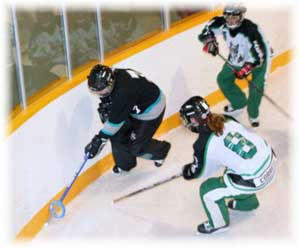
- Read it over carefully and watch the DVD clips by clicking on the links. It will take about 20 minutes.
- Set your defensive goals for the next 10 days. I will help you do this at the end of this tutorial. You will probably have at least two practices and one game in 10 days, if not more.
- Try your new defensive strategies in at least three ice sessions.
- Evaluate yourself at the end of 10 days. How did you do?
- If you have any questions or want tips, email Laura Warner at info@lisabrown.ca and she will help you!
#10 Communicate in the Defensive Triangle
World-class defenders are committed to being verbal in the triangle and letting each other know what is going on. Decide that you are going to be in constant communication with the other players in the triangle by calling out where the offensive players are on the ice are they skating into the zone? Behind the net? Are they in a position to receive a pass? You can call out, “Forward coming in or Right side if you see a forward trying to sneak in behind the triangle.
For example, you might tell your center to get closer to you in the triangle — to tighten up the triangle. Another example would be when there has not been a whistle in a while, the other team has some sustained momentum in your end and you sense that the triangle as a unit is either getting spread out or collapsing back on the net. If you notices, this it is crucial that you communicate with the other D by calling out that they either "push out" or "calm it down, don’t chase", etc.
#9 Stick Flat on Ice in The Triangle
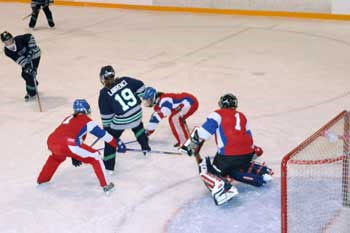
Have you ever wondered why some defensive triangles are so much harder to score on than others? You’re watching them, and their positioning seems exactly the same as your triangle, but they’re stuffing you constantly, and you can’t figure out why?
It’s often because of a super-smart, slick tactic of the low defender. Here’s an unstoppable tactic only top players know about being the ‘Low D’ in the triangle.
Everybody knows that when you’re in the triangle, you must stay low and try to intercept passes. But, what you may not realize is that to block passes effectively, you must have your stick completely flat on the ice. Having a ‘low’ stick just won’t do.
Check out the two clips below. In the first one, the low defender has her stick low on the ice. In the second clip, the low defender has her stick completely flat on the ice.
To pull off a completely flat stick, you will probably have to momentarily change the grip you’re using on your stick. You do this by taking your thumb out from under your stick so you can put your stick flat on the ice. It doesn’t feel very comfortable at first, but you’ll get used to it.
#8 Agility, Agility, Agility in the Triangle
The key physical skill that you need to succeed in the triangle is agility on her skates. Agility allows you to move in the ways you need to move in the triangle. Some examples:
When you step up in the triangle to challenge a forward who is cutting around the center, you must take one or two quick strides forward and then quickly pivot and begin channeling backwards. You must have an explosive first step, be able to pivot while maintaining her balance and then quickly push off for a backwards stride.

When you are pushing out with the center while the offensive player is carrying the ring around the side of the triangle, you must be matching the offensive player’s speed while all the while maintaining a low enough body position to intercept a pass that the offensive player attempts. This essentially requires the ability to skate but also be so low that you could touch your glove to the ice at any moment.
As you learned in the tutorial on Marking Your Check, the best way to work on your agility is by improving your balance on your edges. Check out the following two clips. The first one is a simple technique you can use in practice to develop your agility by improving how well you skate on your inside edges:
The second clip is a live ‘demo’ of Laura Warner using her inside edges to skate around the net and protect the ring easily–even with checkers on her. Notice how she is agile and quick on her inside edges as she wraps around the net:
#7 Anticipate Your Opponent
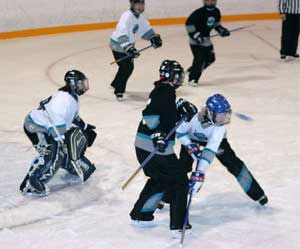
Elite defenders train themselves to be acutely aware of where offensive players are at all times and what they are doing. Laura Warner likes to tell the story of the 2000 World Championships when Finland jumped out to an early 5-0 lead in the first game of a two-game final.
During the first intermission the Canadian team was shaking their heads: what were the Finns doing that was causing so many problems for the defence? The Canadian team set a goal for the second period to simply pay attention to what the Finns were doing to generate their offensive chances.
During the second intermission there was more discussion and the common theme was the realization that the Finns were attacking in waves from high in the zone. This was a new style of attack that the athletes were not used to based on their experiences competing in Canada.
The Finns had generated the bulk of their 5 goals by making a pass to an attacking player who had exited the offensive zone and then picked up the ring as she was coming back in, just over the ringette line. By the time the defenders were aware of the incoming player, they were stepping up too late. That is, they were taking their forward stride just as the attacking player was crashing the triangle; they were not anticipating the pass and stepping up early enough to pivot backwards. If you step up late, then you are flat-footed and totally helpless when the attacking player drives at you. In fact, you are basically skating towards that player while she is driving past you. Here is a video clip of a player stepping up too late:
This is why anticipation is a fundamental defensive skill. Proper channeling requires that you know where the offensive players are and can step up into their lane a second before they make their move. If you are stepping up as they are attacking with the ring, you are burnt. If you step up as the pass is being made, you have time to pivot and channel them away from the net. You have time to get your body in the lane they are trying to attack (in this way anticipation and body positioning go hand in hand).
The Canadian team increased their communication in the triangle and each athlete committed to getting her head on a swivel so she would be more aware of the attacking players. (You learned about head on a swivel in the Tutorial on Marking Your Check). They shut the Finnish attack down in the third period by anticipating passes earlier so they could step up and channel effectively. They mounted an impressive comeback, losing the game by the slim margin of 5-4.
Anticipation is not only important for channeling, it also allows for pass interception. Elite defenders block passes because they know where each attacking player is on the ice at all times and have a sense of where the ring carrier might be looking to move the ring to.
Picture a the following save by a goalie: the attacking team threads pass through the middle of the triangle and the shooter on the low-post has what looks to be a given goal, except that the goalie miraculously gets across in time to get a toe on the one-time shot. The crowd roars and you, the coach asks: how did she get there in time?
Goalies make these types of saves because their head is always on a swivel and they have trained themselves to be constantly aware of where each attacking player is on the ice. Check out the following video clip of players in a triangle who are keeping their head on a swivel and therefore anticipating passes and offensive moves:
#6 FAST Backwards Skating

The core physical skill for playing transitional defense is backwards skating. We thoroughly covered the secrets to backward skating in the Tutorial called "Unparalleled Backwards Skating" and therefore will not review them here.
I will leave you with a nice clip of Laura Warner skating backwards to inspire you to continue working on your backward skating:
#5 The "Give & Take Away"
This one is sneaky.
As a defender, you trap a forward by purposely giving her one option and purposely taking away another. Goalies do this all the time. A goalie will knowingly make one part of the net look open in order to entice the forward into shooting there. For example, some goalies really trust their quick glove-hand save abilities and so will purposely lower their glove an inch or two to encourage the shooter to aim there. Another well-known sport example is in basketball where defenders will often force the point guard to carry the ball up the court using his or her non-dominant hand. Here are different ways you can use the give and take away depending on what’s most important to your team:
- Passes across the top: Some defensive centers have mastered the art of making it look like the pass across the top of the triangle is wide open. You can do this by keeping you stick in close to your body. Watch the ring carrier carefully and just when the ring carrier starts to make a move to pass the ring, put your stick out on the ice to intercept or deflect the pass. Defenders can do this same thing with any passing lane.
- 2-on-1’s: When the other team gets a fast break 2 versus 1 against your team, you must make decide if you are going to defend against the shot (try to stop the shooter) or the pass. Here are some basic instructions on how to play the 2 vs. 1:
Taking away the shot – When you take away the shot, you play a 2 versus 1 much like she would play a 1 versus 1 you channel, focuses on your gap control and bother the shot at the very end. When you take away the shot so aggressively, the attacking player is likely to pass to her teammate.
Taking away the pass – When you take away the pass, you purposely drop off the ring carrier (give her more room than you would if you were properly channeling). Get very low to the ice and put you stick in a position to intercept any passes that might be made. The goalie reads that the defender is preventing the pass across, and so pushes out more aggressively in her net, focusing primarily on the shot, not the pass.
- Give Your Opponent Shots From Outside The Triangle. If your triangle plays very tight, you give the other team shots from the outside but make it very difficult for them to get shots from the middle of the triangle and down low. Your goalie plays aggressively, pushing out in her crease and anticipating shots from the outside rather than down low, on cross-crease passes.
- Give Your Opponents Shots From Down Low. If your triangle plays aggressively and pushes out, you take away outside shots but run the risk of giving up cross-crease passes and low walks into the triangle. Your goalie plays slightly deeper in her net, knowing that most shots will come from in close and she may have to move laterally.

You will need to talk to your coach and teammates to find out how your team is playing these situations. You can then "give and take away" on a regular basis and frustrate the opposition!
#4 Ring protection

The skill of protecting the ring is the ability to keep the ring when someone is trying to check you. Ringette is a game of possession (the team that has the ring more almost always wins) and speed (it is much easier to score on the fast break than versus an established triangle). Protecting the ring during transition is a crucial defensive skill because it ensures your team keeps possession and increases your team’s chances of creating a fast break.
Many athletes think ring protection is primarily about hiding the ring from the opponent. Hiding the ring is a good strategy and, at our summer ringette camps, we teach the athletes to “build a wall†by placing their body between the ring and the checker.
However, to focus on this as the key to protecting the ring is an error. When you concentrate only on hiding the ring, you stop moving your feet. You slow down and lean heavily on your stick and stop skating. This is why hiding the ring must be the second priority while out-skating the checker is the first priority. Check out this DVD clip reviewing excellent ring protection:
Also, review this game-like clip:
Notice the following fine points:
- As soon as she picks up the ring, she starts moving her feet immediately. Most players slow down or stop when they get the ring in a trap zone like the boards.
- She peels around the net, using it to get away from the player who is chasing her. This is because she knows that the girl chasing her will have to drop behind her (or risk skating right into the net!). This is a clever way to the net as a teammate.
- The ring carrier splits the checkers. What I mean by this is that she skates in between the two checkers rather than try to avoid them both by skating into the corner of the ice. Splitting checkers is a nifty way of avoiding pressure, because when you split checkers, you make them attack you 1 vs. 1 instead of them attacking you together. But remember: if you split checkers, you must be skating at top speed!
#3 Make Breakout Passes From The Middle of the Ice

You can create fast break chances for your team if you make excellent breakout passes.
To do this, train yourself to get to the middle of the ice and stay away from "trap zones". A trap zone in ringette is anywhere the ring carrier can get "stuck" along the boards and close to the blue lines.
Often, it’s not enough to just skate at top speed. If you skate at top speed into a trap zone, you still might still get caught. Good checkers will force you towards the boards where you will eventually have to slow down and stop. When this happens, you can kiss the ring goodbye.

Even if you don’t get checked, being stuck along the boards means you have very few quality passing options.
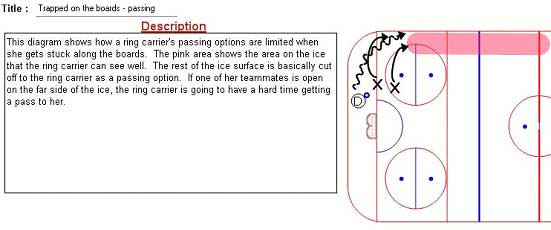
You run out of good passing options if you doesn’t fight to get to the middle of the ice. Instead, you might dump the ring away, which creates a turnover. Your job is to train yourself to skate towards the middle of the ice. In fact, you must learn to "fight" to get to the middle of the ice because checkers will try to force you into trap zones. You CANNOT accept what the checkers are giving her. You must use your foot speed to force your way to the middle.
From this position, you will be very hard to check AND you can make a pass to any place on the ice surface. That is SMART ringette.
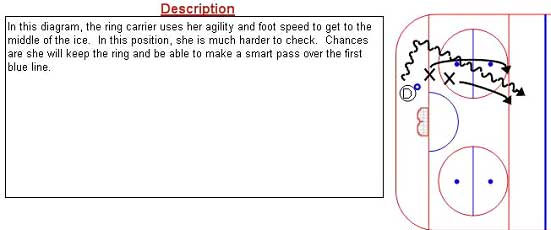
#2 Step Up in the Defensive Triangle
It’s crucial that you know exactly what to do when a forward is skating around the top of the triangle.
The key strategy to making your triangle a defensive fortress is to ensure that when you are the low defender at the bottom of the triangle that you are "stepping up" in a timely and correct fashion.
For a brief tutorial on how to step up in the defensive triangle, Click Here.
#1 Channeling Forwards Away from the Net
FINALLY the Top Defensive Strategy of All Time: Channeling forwards away from the net.
Effective channelling is straightforward, and can take place 1 vs. 1 or in the triangle. It has two components: a) the defender should be goal side, which means is between the forward and the net and b) she keeps a stick length gap between herself and forward, which is gradually closes as the forward skates closer to the net.
You’ve seen it many times before, but here’s the DVD tutorial on channeling AGAIN. If you burn it into your brain and become the world’s greatest channeling defender, you will be able to write your own ticket in ringette:
Your ADVANCED Defensive Goal
In the space below, select one ADVANCED defensive goal for the next month based on today’s tutorial:
______________________________________________________________________________
______________________________________________________________________________
______________________________________________________________________________
______________________________________________________________________________
Personal Evaluation
At the end of the month, write at least two comments in the space below. How did you do? What was easy for you? Difficult? What improvements did you make over the last 30 days?
______________________________________________________________________________
______________________________________________________________________________
Light it up out there,
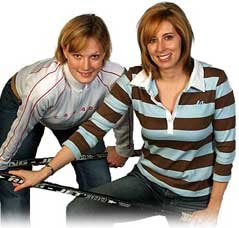
Your friend,
Lisa B.


